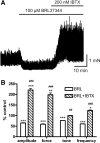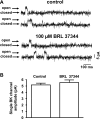Stimulation of beta3-adrenoceptors relaxes rat urinary bladder smooth muscle via activation of the large-conductance Ca2+-activated K+ channels
- PMID: 18799656
- PMCID: PMC2584988
- DOI: 10.1152/ajpcell.00001.2008
Stimulation of beta3-adrenoceptors relaxes rat urinary bladder smooth muscle via activation of the large-conductance Ca2+-activated K+ channels
Abstract
We investigated the role of large-conductance Ca(2+)-activated K(+) (BK) channels in beta3-adrenoceptor (beta3-AR)-induced relaxation in rat urinary bladder smooth muscle (UBSM). BRL 37344, a specific beta3-AR agonist, inhibits spontaneous contractions of isolated UBSM strips. SR59230A, a specific beta3-AR antagonist, and H89, a PKA inhibitor, reduced the inhibitory effect of BRL 37344. Iberiotoxin, a specific BK channel inhibitor, shifts the BRL 37344 concentration response curves for contraction amplitude, net muscle force, and tone to the right. Freshly dispersed UBSM cells and the perforated mode of the patch-clamp technique were used to determine further the role of beta3-AR stimulation by BRL 37344 on BK channel activity. BRL 37344 increased spontaneous, transient, outward BK current (STOC) frequency by 46.0 +/- 20.1%. In whole cell mode at a holding potential of V(h) = 0 mV, the single BK channel amplitude was 5.17 +/- 0.28 pA, whereas in the presence of BRL 37344, it was 5.55 +/- 0.41 pA. The BK channel open probability was also unchanged. In the presence of ryanodine and nifedipine, the current-voltage relationship in response to depolarization steps in the presence and absence of BRL 37344 was identical. In current-clamp mode, BRL 37344 caused membrane potential hyperpolarization from -26.1 +/- 2.1 mV (control) to -29.0 +/- 2.2 mV. The BRL 37344-induced hyperpolarization was eliminated by application of iberiotoxin, tetraethylammonium or ryanodine. The data indicate that stimulation of beta3-AR relaxes rat UBSM by increasing the BK channel STOC frequency, which causes membrane hyperpolarization and thus relaxation.
Figures







References
-
- Andersson KE, Arner A. Urinary bladder contraction and relaxation: physiology and pathophysiology. Physiol Rev 84: 935–986, 2004. - PubMed
-
- Andersson KE, Wein AJ. Pharmacology of the lower urinary tract: basis for current and future treatments of urinary incontinence. Pharmacol Rev 56: 581–631, 2004. - PubMed
-
- Biers SM, Reynard JM, Brading AF. The effects of a new selective β3-adrenoceptor agonist (GW427353) on spontaneous activity and detrusor relaxation in human bladder. BJU Int 98: 1310–1314, 2006. - PubMed
-
- Brown S, Cui X, Hristov K, Petkov G. Inhibitory mechanism of BRL37344, a specific β3-adrenoceptor agonist, on guinea pig and rat urinary bladder smooth muscle contractions: role of the BK channel. FASEB Experimental Biology, Washington, DC, 2007.
Publication types
MeSH terms
Substances
Grants and funding
LinkOut - more resources
Full Text Sources
Research Materials
Miscellaneous

